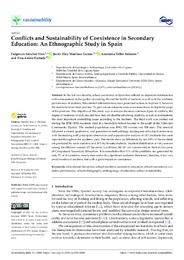Resumen :
first_pagesettingsOrder Article Reprints
Open AccessArticle
Conflicts and Sustainability of Coexistence in Secondary Education: An Ethnographic Study in Spain
by Fulgencio Sánchez Vera 1,*ORCID,Javier Eloy Martínez Guirao 2,*ORCID,Anastasia Tellez Infantes 3ORCID andFina Antón Hurtado 2ORCID
1
Departamento de Sociología y Antropología, University of La Laguna, 38200 San Cristobal de la Laguna, Spain
2
Departamento de Ciencia Política, Antropología Social y Hacienda Pública, Universidad de Murcia, 30100 Murcia, Spain
3
Departamento de Ciencia Sociales y Humanas, Miguel Hernandez University, 03202 Elche, Spain
*
Authors to whom correspondence should be addressed.
Sustainability 2021, 13(21), 11888; https://doi.org/10.3390/su132111888
Submission received: 30 September 2021 / Revised: 15 October 2021 / Accepted: 22 October 2021 / Published: 27 October 2021
(This article belongs to the Special Issue School Violence, Diversity and Psychosocial Environment: Bullying, Cyberbullying, Discrimination and Social Exclusion)
Downloadkeyboard_arrow_down Versions Notes
Abstract
In the last two decades, school coexistence in Spain has suffered an important deterioration with consequences in the quality of working life and the health of teachers, as well as in the academic performance of students. Educational administrations have promoted actions to improve it; however, the results have not been positive. To give a more adequate answer we must know in depth the scope of the problem. The objective of this study was to analyze the most common types of conflicts, the degree of incidence of each one and how they are distributed among students, as well as to determine the most important underlying cause according to the teachers. The field work was carried out during the 2018/2019 academic year, in a Secondary School located in the south of the Valencian Community (Spain). The student population was 1040, 532 women and 508 men. The research followed a mixed, qualitative, and quantitative methodology, making use of in-depth interviews with the teaching staff, participant observation and a quantitative analysis of 1501 incidents that were reported throughout the academic year. The results show us differences by sex: 84% of the incidents are produced by male students and 16% by female students. Incident distribution is very uneven among the different courses. Of the center’s problems, 88.14% are concentrated in the first two years of Compulsory Secondary Education. It is remarkable that 51% of the problems are generated by only 3% of the students, mostly men and with a significant academic disinterest; therefore, it is a very small number of students, but with a great impact on coexistence
|
 La licencia se describe como: Atribución-NonComercial-NoDerivada 4.0 Internacional.
La licencia se describe como: Atribución-NonComercial-NoDerivada 4.0 Internacional.
.png)
